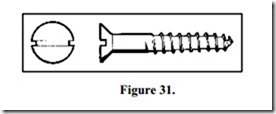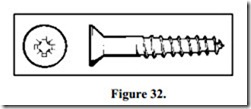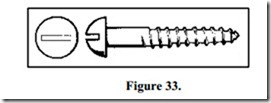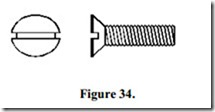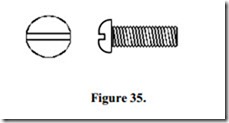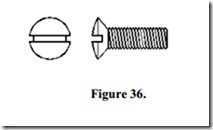Fixing Devices
There is a wide range of fixing devices in use in the electrical trade. They can be classified according to their use with particular building materials such as wood, concrete, metal, plasterboard etc. The following are examples of some types of woodscrews which are widely available.
Figure 31 illustrates a slotted countersunk head woodscrew. This screw is used to fix items which have countersunk fixing holes. The screw head finishes flush with the surface of the work.
Figure 32 illustrates a pozidrive countersunk head woodscrew. Its application is the same as the previous type but it has the advantage that the screwdriver used is easier to locate and less likely to slip while in use.
Figure 33 illustrates a round head woodscrew which is used to fix items which do not have countersunk or counterbored holes, e.g. plastic or steel trunking. The reason for this is that the screw has no sharp edges which might damage cable insulation. This screw also provides a more decorative finish where fixing screws remain visible.
All of these woodscrews are available in a range of sizes. They are sized according to their length, and diameter of the thread, in millimetres. A screw having a diameter of 4mm and a length of 25mm will be designated as an M4 x 25. The type of head incorporated will also be stated.
Machine Thread Screws
Machine thread screws are used to fix switches, sockets, ceiling roses etc., to their respective boxes. The following are examples of the more common types encountered in the electrical trade.
Figure 34 illustrates a slotted countersunk head machine thread screw. It is used to fix ceiling roses and battenholders to boxes which have machine thread inserts. The screw diameter in common use is 4mm. They are available in various length such as 6mm, 12mm, 16mm, 20mm, 25mm, 30mm and 40mm. They are manufactured from brass and have a thread pitch of 0.7mm.
Figure 35 illustrates a pan head screw. It is used to fix items similar to those mentioned previously which do not have countersunk fixing holes. Pan head screws provide a neat finish where fixing screws remain visible.
Figure 36 illustrates a raised countersunk head screw. It is used to fix switches, sockets etc., to boxes which have machine thread inserts. The diameter in common use is 3.5mm. They are available in 20mm, 25mm, 60mm,75mm and 100mm lengths. They are generally brass with a nickel plated finish and have a thread pitch of 0.6mm.
